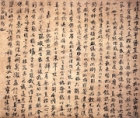Asian Gallery (Toyokan) Room 8
October 30, 2007 (Tue) - December 27, 2007 (Thu)
The calligraphy of Zen priests is called bokuseki or "traces left by ink." This word signifies calligraphy in general, but in Japan it is often used for the calligraphy of Zen priests from the Song (960-1279) and Yuan (1271-1368) China, as well as from the Kamakura through Edo period Japan (1603-1868). In the wabi style tea ceremony of Japan, bokuseki was considered the pinnacle of hanging scrolls used to decorate the tokonoma alcove in tea rooms. Bokuseki was not always appreciated for excellent calligraphic skill; the writer's personality was often more important. Writings by high priests who had undergone hard ascetic training were considered to have a unique charm that is absent in literati calligraphy, and people saw Zen priests' personalities and minds in them.
Hogo (words explaining the teachings of Buddha) by Yuanwu Keqin (Jap. Engo Kokugon, 1063-1135) from the Song dynasty has been ranked at the top of bokuseki, being the oldest of its kind and also because of the calligrapher's high position as a priest. There is a legend that it was washed ashore in a cylindrical case made of paulownia wood at Bonotsu in Satsuma province on Kyushu island, which gave the calligraphy the nickname "Nagare (drift) Engo". It is the first half of a certificate of full proficiency in priesthood given to his pupil Huqiu Shaolong (1077-1136). The certificate was cut in half by the tea master Furuta Oribe (1543-1615) after consulting with Shun'oku Soen (1529- 1611) as requested by the feudal lord Date Masamune (1567-1636). Fortunately, the entire text was transcribed by Kugaku Soko (1465-1548), Un'ei Soi (1560-1603) and others, from which the certificate is known to have been written in December of 1124.
This thematic display features "Nagare Engo" with all related materials, including the paulownia case and a letter by Date Masamune. Bokuseki by Dahui Zonggao (1089-1163), Wushun Shifan (1177-1249), Liao'an Qingyu (1288-1363) and Xutang Zhiyu (1185-1269) are also on display.

